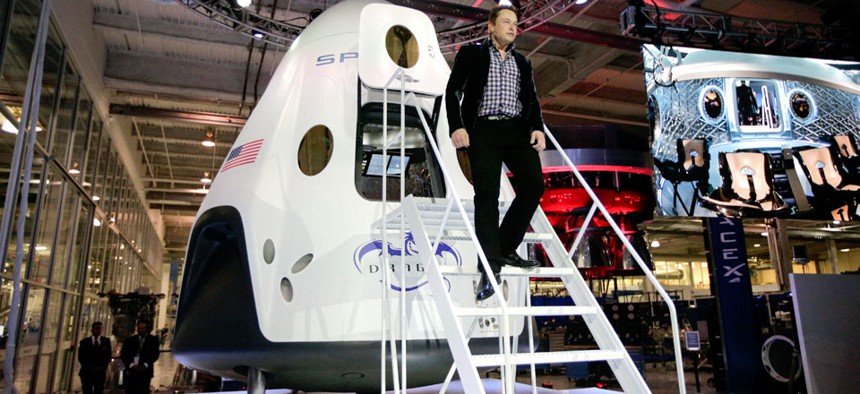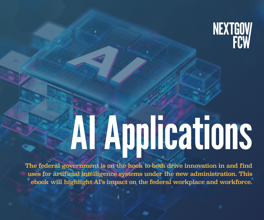How SpaceX Leapfrogged NASA and Became a Serious Space Company

Elon Musk, CEO and CTO of SpaceX, walks down the steps while introducing the SpaceX Dragon V2 spaceship. Jae C. Hong/AP
SpaceX has a chance at beating the aerospace giant Boeing to be the first private company to fly humans into orbit.
This post has been corrected.
The Space Exploration Technology rocket factory is a large, white hangar-like building near Los Angeles international airport, with a parking lot filled with late-model motorcycles and Tesla electric cars. The vast metal structure once churned out 737 fuselages for Boeing. When you get through the front doors, past security and a cubicle farm stretching the width of the building, there it is: Science fiction being wrought into shape, right in front of you.
Right in front of all the workers, too. The company’s two-floor cafeteria is practically on and overlooking the manufacturing floor. Designers and accountants can eat lunch watching technicians build space capsules and rocket stages. There’s a lot to see: Rockets, like good suits, are bespoke objects, hand-made to order; a SpaceX tour guide says much of the work is too precise for robotic assembly.
Visitors can’t snap pictures—the technology is considered sensitive to national security. An enormous robot encircles a carbon-fiber shell that enfolds a satellite mounted on top of a rocket, using sonic waves to test for invisible imperfections. Human workers align nine rocket engines in an octagonal frame before they are installed into the enormous aluminum tube; others use a crane to lift a large panel and move it between workspaces. Even higher overhead, the first Dragon space capsule to leave the atmosphere and come back again hangs as a trophy. Mounted beside it is a project still in development: An enormous metal arc, one leg of a landing tripod large enough for a rocket.

Last month, NASA said it would pay SpaceX its largest single contract ever , $2.6 billion, to shuttle US astronauts up to the International Space Station (ISS). It’s one of two companies that will build vehicles to replace the discontinued space shuttle and return the US to the list of spacefaring nations. The other, SpaceX’s frequently testy competitor Boeing, will do the same job but at more than half again the cost—some $4.2 billion.
In fact, SpaceX has a chance at beating the aerospace giant to be the first private company to fly humans into orbit. This is an enormous milestone for the firm, and also its most dangerous task so far. But building cost-effective space vehicles gives SpaceX a chance to save US space efforts from their own torpor.
Despite successes in planetary science, like the Curiosity rover on Mars, NASA’s manned space program has been floundering. The first plan to replace the space shuttle was cancelled; a new effort to send people to explore the solar system is behind schedule and over budget, to the point where it may be unfeasible . Even the basic effort of getting astronauts up to the ISS—real estate in which the US has invested $75 billion—has been outsourced to Russia .
In the private sector, the US, once the leader in satellite launches, now lags behind European and Russian competitors. An existing joint venture between Lockheed Martin and Boeing, the United Launch Alliance (ULA), is using engines bought from a Russian state company until 2017. And as China and India show their prowess to catch-up to the advanced economies with cost-conscious space stations and Mars probes of their own, a US side-bet on commercial space companies has now become the most likely way for the US to get off the ground.
When NASA officials first got involved with SpaceX eight years ago, they thought they were hiring a temp worker for scut work—a so-called “space taxi” while the government focused on higher aims. But now the commercial project may be NASA’s best hope for getting humans into space.
A vanity project on a multi-planetary scale
When Elon Musk founded SpaceX in 2002, it was, at best, a millionaire’s flight of fancy. He had made his fortune from tech startups Zip2 and PayPal, and was still two years away from starting Tesla, the electric-car firm.
Musk, as he will gladly tell you , has a vision: Colonize Mars and make humans a multi-planet civilization. He sees it as insurance against a global catastrophe that leads to human extinction. Per Musk, the only sensible policy in this universe is redundancy. Newly wealthy and with time on his hands, he concocted a scheme to send a greenhouse full of plants to Mars as a kind of grand gesture, but couldn’t find any cost-effective rocket to send it there, even on a multi-millionaire’s budget.
He did find people like Tom Mueller, a frustrated engineer at the conglomerate TRW’s aerospace division, who was building a rocket engine for fun in his garage. That—the largest liquid-fueled engine ever built by an an amateur—turned out to be the earliest version of the Merlin, which powers SpaceX’s rockets. Musk also met Hans Koenigsmann, a German engineer who became the company’s fourth technical employee, at a rocketry club launch in the Mojave desert. “My German accent helps in presentations,” Koenigsmann says . “When I say, ‘This will work,’ it is more convincing than other accents for some reason.”
Musk decided to start a company to provide the service he couldn’t find—an affordable ticket to Mars. Successful tech entrepreneurs love starting space companies: Jeff Bezos (Amazon), Paul Allen (Microsoft), Larry Page and Eric Schmidt (Google), and Richard Branson (Virgin) are all involved in firms dedicated to space tech. Most are seen, to varying degrees, as vanity projects.
“So many of his friends advised him not to do SpaceX,” Luke Nosek, who helped build PayPal with Musk, told Quartz.
Nosek is now a member of SpaceX’s board of directors.
Finding a partner in crime
Just as Musk’s company was beginning to approach the space business with a clean slate, NASA was, too. The impending expiration of the space shuttle program, which flew US astronauts and cargo into orbit from 1981 to 2011, prompted a scattered response in the US space agency. In 2005, the Bush administration launched the first successor program, Constellation, intended as a ticket to both the ISS and the moon. The cost was originally estimated at $97 billion; it would eventually be cancelled in 2009.
But Mike Griffin, the aerospace engineer who became the top NASA administrator in 2005, had a bit of an unusual background: He was a former president of In-Q-Tel, the CIA’s in-house venture-capital fund for national security tech. And like Musk, he saw space travel as a key to the future of humanity. He just thought it was a job for NASA, not the private sector.
With so much money going into Constellation, Griffin decided to spend $500 million on a commercial space program, outside of the traditional NASA contracting approach, in the hopes of producing a cheap way to service the orbital distraction while NASA focused on grander aspirations. This commitment had his top staff wondering if he saw the ISS—at a total cost of $150 billion, the most expensive single object ever built by mankind, but of relatively limited scientific and economic value—as “a huge rat hole we’re just throwing money down.”
Advising Griffin was a physicist and venture capitalist, Alan Marty. One of the first things he did was write a two-page book report on Clayton Christensen’s classic Silicon Valley tome The Innovator’s Dilemma and distribute it to senior NASA executives. At Marty’s insistence, NASA’s attorneys were able to exploit a loophole created by the slapdash nature of the agency’s original founding. In the panic after the Soviet Union got to space first with Sputnik, the White House had demanded a civil space agency fast, and to avoid missing any opportunities, a young attorney had added a kind of universal action clause (section 203, sub-section a, part 5) to the 1958 law that founded NASA. “You know how Sherwin-Williams [Company] paint covers the world?” NASA general counsel Michael Wholley said . “He basically said, ‘If I’ve forgotten something, use this.’”
And so in 2006 Griffin and his colleagues came up with a system to sort-of invest in two companies, SpaceX and Rocketplane Kistler, to develop space transit. There would be no sharing of equity or intellectual property, but also no guarantee of payment before technological and financial milestones were reached.
“I knew enough about the federal government to know that if you invested money and you got none of your money back, everybody would get angry,” Marty said. “But it also turns out that if you invest money and you get five times your money back, everybody gets angry too, because then you’re competing with the private sector.”
Rocketplane Kistler would eventually be dropped from the program, eventually flaming out in bankruptcy after failing to raise enough money from New York hedge funds and pension investors it targeted just as the economic crisis began. SpaceX, on the other hand, would eventually collect $396 million from NASA while contributing $454 million of outside capital, including an initial $100 million of Musk’s own money in 2006.
The company’s outside fundraising strategy was simple: Turning to Musk’s deep-pocketed friends in Silicon Valley, who were more willing than hard-pressed New York financiers to take a flyer on something new. There was also an attractive quirk of the satellite launch business: Customers pre-pay to build their rocket. That meant if the company could prove its concept in a successful test, the company wouldn’t need to raise another round of working capital, protecting early investors’ stakes from dilution.
What does SpaceX actually make?

Rockets are marvelous pieces of technology. They seem to rise in fairly stately fashion when you watch them launch, but to reach orbit they must fly 7.7 km per second or about 18,000 miles per hour, nearly 25 times the speed of sound in air. Nothing else made by man goes that fast with people in it. Rockets are mostly fuel—for SpaceX, $200,000 worth of kerosene and liquid oxygen—with an almost delicate metal skin, mostly aluminum. Musk once asked an investor to imagine his 64 meter (224 ft) rocket, shrunk down to the size of a Coca-Cola can: The walls of the tiny explosive would be many times thinner than the drink in your hand.
It is easier and cheaper to use solid-fuel engines. That would typically make them the first choice of the company’s chief designer—also Musk—but for the fact they are harder to control once ignited. For safety’s sake, more complex liquid-fueled rockets are the standard for taking people to space. The engines are spidered with metal capillaries that use the vessel’s own chilled fuel as coolant to keep the 3-D printed nozzle from melting in the wash of its own exhaust. Human flight was always the standard to which Musk’s associates say he aspired; and so the Merlin was the first new liquid-fueled rocket engine to fly in the United States since the 1990s.
Rockets headed for space typically have two stages. The first stage provides the massive thrust to get into space; then it’s discarded, and the second stage glides the payload to its final destination in orbit. A satellite, encased in a custom-made carbon fiber fairing, or a Dragon space capsule full of cargo—someday, passengers—perches on top of the rocket at launch. SpaceX’s first rocket prototype, the Falcon 1, used one Merlin engine in its first stage. There are nine in the Falcon 9 rocket that is the company’s main product. And there will be 27 in the putative Falcon Heavy, as yet unrealized, for massive cargo—and trips to Mars.
Falcon, Merlin, Kestrel, and Dragon: Not the Victorian virtues—Enterprise, Endeavor, Discovery—honored by the space shuttles they replace, nor competitor NASA’s classical Atlas, Orion, Apollo, and Saturn. SpaceX’s machines were made by people who read pulp fantasy novels as children, or the paperback science fiction of Musk’s childhood in Pretoria, South Africa.
The only thing that matters is cost

Regardless of its inspirations, the company was forced to adopt a prosaic initial goal: Make a rocket at least 10 times cheaper than is possible today. Until it can do that, neither flowers nor people can go to Mars with any economy. With rocket technology, Musk has said , “you’re really left with one key parameter against which technology improvements must be judged, and that’s cost.”
SpaceX currently charges $61.2 million per launch. Its cost-per-kilogram of cargo to low-earth orbit, $4,653, is far less than the $14,000 to $39,000 offered by its chief American competitor, the United Launch Alliance. Other providers often charge $250 to $400 million per launch; NASA pays Russia $70 million per astronaut to hitch a ride on its three-person Soyuz spacecraft. SpaceX’s costs are still nowhere near low enough to change the economics of space as Musk and his investors envision, but they have a plan to do so (of which more later).
The secret to the low cost is relatively simple, at least in principle: Do as much as possible in-house, in an integrated manufacturing facility, with modern components; and avoid the unwieldy supply chains, legacy designs, layers of contractors, and “cost-plus” billing that characterized SpaceX’s competitors. Many early employees were attracted to the company because they wanted to avoid the bureaucracy of the traditional aerospace conglomerates.
“I guess I would call them bureaucratic integrators, people at large entities integrating other people’s technologies,” says Scott Nolan, who joined the company out of college as an early employee and is now a partner at Founders Fund. “SpaceX was the first real tech startup in that space developing their whole platform from the ground up, questioning everything.”
But there’s a reason for everything to be the way it is, and the reason the dominant aerospace contractors were slow-moving behemoths of paperwork is that their prime customers—indeed, the prime customers of the entire space world—are governments. From SpaceX’s point of view, much of the blames lies with cost-plus contracting, the common government strategy of hiring companies to do work and paying their expenses plus a guaranteed profit margin.
“When you do that, your engineering force is brain-dead,” Nosek says. “The incentive structure destroyed their ability to create true innovation.”
At first, the partnership between a government agency used to paying whatever bill it was presented with and a start-up bent on cutting every corner it could find went much as you might imagine. “For every NASA person you put on my site, I’m going to double the price,” Musk warned Marty. The company made hatch handles out of parts for bathroom stall latches to save $1,470, and found that using racing-car safety belts to strap in astronauts was more comfortable and less expensive than custom-built harnesses. It used live people inside a full-size model to make sure that astronauts could move about the cargo capsule, rather than computer simulations. SpaceX executives disdained NASA’s love of acronyms and documentation. Employees took pride in working late on Friday nights.
“They’d say, ‘Well, we could go buy this from this vendor, but it’s like $50,000. It’s way too expensive, it’s ridiculous. We could build this for $2,000 in our shop,'” said Mike Horkachuck , the NASA official who was the primary liaison with the company. “I almost never heard NASA engineers talking about the cost of a part.”
But NASA did bring a focus to the company, one that other space start-ups often seem to lack. And, just as important, it brought early revenue. ‘”Okay, we have a schedule, we have milestones, we have funding,’ which was obviously key as well at the time, being such a small company,” Giger said of the NASA award. “That really gave us focus.”
“I think we brought them up from being a little 100-man company, if that, to what they are today,” Horkachuck said. “Early on, [NASA] was what was keeping the lights on in the company. They’ve just evolved into less of a hobby shop and more of a real aerospace company that’s building production rockets.”
But SpaceX always thought of itself as a tech firm, and its clashes with NASA often took a form computer developers—or anyone familiar with the troubled roll-out of healthcare.gov —would recognize as generational. SpaceX followed an iterative design process, continually improving prototypes in response to testing. Traditional product management calls for a robust plan executed to completion, a recipe for cost overruns.
“We weren’t just going to sit there and analyze something for years and years and years and years to the nth degree,” said David Giger , a SpaceX engineer. “SpaceX was built on ‘test, test, test, test, test.’ We test as we fly. We always say that every day here, ‘Test as you fly.'”
That was to become painfully evident in its first attempts at flying.






